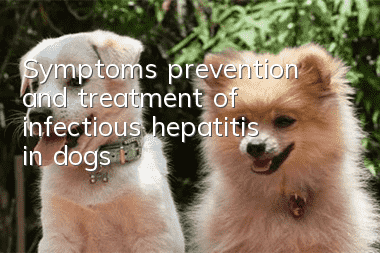Symptoms, prevention and treatment of infectious hepatitis in dogs

Canine infectious hepatitis is an acute septicemic infectious disease in canines caused by canine adenovirus type I. So what are the symptoms of canine infectious hepatitis and how to treat it?
Short-legged and long-bodied Terrier
Clinical symptoms of canine infectious hepatitis
The English name of canine infectious hepatitis virus is Canine infectious hepatitis. Canine infectious hepatitis is an acute septicemic infectious disease in canines caused by canine adenovirus type I. It is mainly infected through the digestive tract and may also be infected through the placenta. .
1. Hepatitis type
Newborn dogs and dogs under 1 year old are mostly the most acute type. Body temperature increased to 41°C, abdominal pain, vomiting, diarrhea, and blood in the feces. Most die within 24 hours. In cases with a longer course of disease, in addition to the above symptoms, depression, watery nasal discharge, conjunctival inflammation, and shyness and tearing may be seen. Bleeding or bleeding spots in the mouth and gums. The more special symptoms are subcutaneous edema of the head, neck, eyelids and abdomen, and mild jaundice of the mucous membranes can be seen. Mild cases only show symptoms such as loss of appetite, slightly higher body temperature, and runny nose, which usually last for 2 to 3 days.
2. Breathing type
Sick dogs have elevated body temperatures, accelerated breathing, fast heartbeats, and irregular rhythms. cough. There is serous or purulent nasal fluid. Some sick dogs vomit or pass loose stools. Some sick dogs have swollen tonsils accompanied by pharyngitis.
A large amount of serous or blood-like fluid can be seen in the abdominal cavity of dead dogs with hepatitis. The liver is enlarged and has bleeding spots or spots. Bleeding may be seen in the gastrointestinal tract. Lymph nodes all over the body are swollen and bleeding. In respiratory cases, changes such as lung enlargement and congestion, bronchial lymph node bleeding, tonsil enlargement and bleeding can be seen.
It is not difficult to diagnose based on the above characteristics. Since the virus has the ability to agglutinate human type 0 red blood cells, chicken and guinea pig red blood cells, red blood cell agglutination and red blood cell agglutination inhibition tests can be conducted where conditions permit. During diagnosis, attention should be paid to distinguishing it from canine distemper and canine leptospirosis.
Key points of prevention and treatment of infectious hepatitis
The main manifestations of canine infectious hepatitis are blue discoloration of the corneas of sick dogs, jaundice, anemia, etc. Laboratory examination can observe changes in the dog's hemogram, decrease in red blood cell count, hemoglobin, specific volume, and decrease in white blood cells. Since the treatment of canine infectious hepatitis is complicated, owners are advised to seek medical attention promptly to avoid delaying the dog’s condition.
Feeding and management should be strengthened and comprehensive veterinary health and prevention measures should be strictly implemented. Get regular immunizations. Commonly used vaccines include canine infectious hepatitis attenuated vaccine. Each dog is injected with 1.5ml subcutaneously after weaning, and another 2ml is injected at intervals of 3 to 4 weeks. byAfterwards, inject once every six months, 2ml each time. The immunity period is half a year. This vaccine should not be used during an epidemic. There are also two vaccines for canine infectious hepatitis and canine parvovirus enteritis and five vaccines for dogs. When a dog becomes ill, in order to alleviate the condition and control the infection, canine infectious hepatitis hyperimmune serum can be used. Each dog can be injected subcutaneously or intramuscularly at 2m1 per kilogram of body weight for 3 days. Broad-spectrum antibiotics can be used to prevent secondary infections. It is also very necessary to take appropriate symptomatic and systemic treatments for the symptoms of sick dogs. For example, Gantailo tablets can be taken orally to protect the liver and promote gallbladder. In order to improve the general condition and enhance the body's resistance, infusions and multivitamin preparations can be given. Dogs that have no chance of being cured should be immediately culled, eliminated, and treated harmlessly. The polluted environment can be disinfected with 3% formalin, caustic soda water, sodium hypochlorite or 0.3% peracetic acid.
Precautions for the treatment of canine infectious hepatitis
Canine infectious hepatitis is an acute septicemia infection in dogs. It mainly destroys the center of liver lobules, the occurrence of inclusion bodies in the nuclei of liver parenchymal cells and cortical cells, and prolongs the coagulation time. Canine infectious hepatitis is mainly infected through the digestive tract, and puppies aged 2 months to one year old are more susceptible to infection. So what issues should dogs infected with the disease pay attention to during treatment so that they can get better faster?
1. Canine infectious hepatitis is caused by canine infectious hepatitis virus through the digestive tract. It has the characteristics of wide prevalence, rapid spread, and high incidence. Therefore, when sick dogs are found, they should be isolated in time to prevent the spread of the epidemic source.
2. Strengthen the feeding and management of sick dogs, and carry out sanitation and disinfection of the surrounding environment.
3. Develop an immunization program, prepare vaccinations, and improve the body's immunity. At present, the two-combination vaccine for canine distemper (detailed introduction) and the five-combination vaccine for canine distemper are widely used. The first vaccination is given at 2 to 3 months of age, and again after 20 days.
4. Early detection, early diagnosis and early treatment of sick dogs can reduce death or corneal damage and improve the cure rate. For corneal injuries that are discovered late and occur, the dog should be given mental comfort and encouraged to take medication to increase its confidence in regaining sight.
Recommended Good Things
Aineng Pet Odor Eliminating Disinfectant can effectively remove body odor/feces odor and other odor molecules! Effective in treating skin diseases caused by fungi/bacteria! Can kill parvovirus/canine distemper virus/coronavirusetc!
It is edible grade for pets, does not contain fragrances, does not contain chemicals, can be sprayed directly, and is harmless to human pets!
Consultation: 13028809308 (WeChat synchronization)
Scan the QR code on WeChat to enter the purchase
- What are the symptoms of dog enteritis?
- How to tell if a Corgi is pure or not?
- Learn these points and your dog’s health status will be clear at a glance
- How to deworm dogs? Dog deworming method steps
- How to make dogs digest chicken bone food
- Couple keeps pets and enjoys high-end treatment, netizens expressed envy after watching it
- How to prevent canine distemper infection
- Do puppies get cataracts because of improper feeding?
- How to protect your dog’s meat pads?
- Do Corgis have body odor? How to get rid of body odor?



